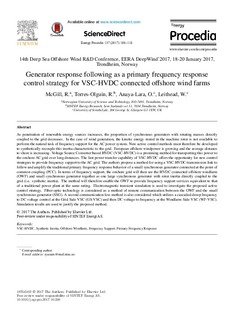| dc.contributor.author | McGill, Ryan | |
| dc.contributor.author | Torres Olguin, Raymundo E. | |
| dc.contributor.author | Anaya-Lara, Olimpo | |
| dc.contributor.author | Leithead, W. | |
| dc.date.accessioned | 2017-12-19T08:46:58Z | |
| dc.date.available | 2017-12-19T08:46:58Z | |
| dc.date.created | 2017-12-18T14:43:21Z | |
| dc.date.issued | 2017 | |
| dc.identifier.citation | Energy Procedia. 2017, 137 108-118. | nb_NO |
| dc.identifier.issn | 1876-6102 | |
| dc.identifier.uri | http://hdl.handle.net/11250/2472699 | |
| dc.description.abstract | As penetration of renewable energy sources increases, the proportion of synchronous generators with rotating masses directly coupled to the grid decreases. In the case of wind generation, the kinetic energy stored in the machine rotor is not available to perform the natural task of frequency support for the AC power system. New active control methods must therefore be developed to synthetically recouple this inertia characteristic to the grid. European offshore windpower is growing and the average distance to shore is increasing. Voltage Source Converter based HVDC (VSC-HVDC) is a promising method for transporting this power to the onshore AC grid over long distances. The fast power transfer capability of VSC-HVDC offers the opportunity for new control strategies to provide frequency support to the AC grid. The authors propose a method for using a VSC-HVDC transmission link to follow and amplify the traditional primary frequency response behavior of a small synchronous generator connected at the point of common coupling (PCC). In terms of frequency support, the onshore grid will then see the HVDC connected offshore windfarm (OWF) and small synchronous generator together as one large synchronous generator with rotor inertia directly coupled to the grid (i.e. synthetic inertia). The method will therefore enable the OWF to provide frequency support services equivalent to that of a traditional power plant at the same rating. Electromagnetic transient simulation is used to investigate the proposed active control strategy. Fiber-optic technology is considered as a method of remote communication between the OWF and the small synchronous generator (SSG). A second communication-less method is also considered which utilizes a cascaded droop frequency to DC voltage control at the Grid Side VSC (GS-VSC) and then DC voltage to frequency at the Windfarm Side VSC (WF-VSC). Simulation results are used to justify the proposed method. | nb_NO |
| dc.language.iso | eng | nb_NO |
| dc.publisher | Elsevier | nb_NO |
| dc.rights | Attribution-NonCommercial-NoDerivatives 4.0 Internasjonal | * |
| dc.rights.uri | http://creativecommons.org/licenses/by-nc-nd/4.0/deed.no | * |
| dc.title | Generator response following as a primary frequency response control strategy for VSC-HVDC connected offshore wind farms | nb_NO |
| dc.type | Journal article | nb_NO |
| dc.type | Peer reviewed | nb_NO |
| dc.description.version | publishedVersion | nb_NO |
| dc.source.pagenumber | 108-118 | nb_NO |
| dc.source.volume | 137 | nb_NO |
| dc.source.journal | Energy Procedia | nb_NO |
| dc.identifier.doi | 10.1016/j.egypro.2017.10.338 | |
| dc.identifier.cristin | 1529122 | |
| dc.description.localcode | © 2017 The Authors. Published by Elsevier Ltd. This is an open access article under the CC-BY-NC-ND 4.0 license (http://creativecommons.org/licenses/by-nc-nd/4.0/) | nb_NO |
| cristin.unitcode | 194,0,0,0 | |
| cristin.unitname | Norges teknisk-naturvitenskapelige universitet | |
| cristin.ispublished | true | |
| cristin.fulltext | original | |
| cristin.qualitycode | 1 | |

